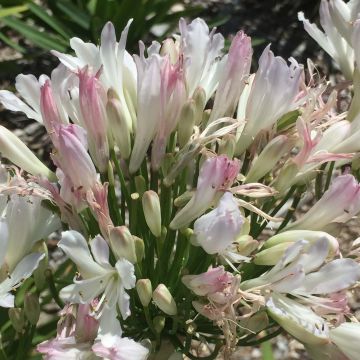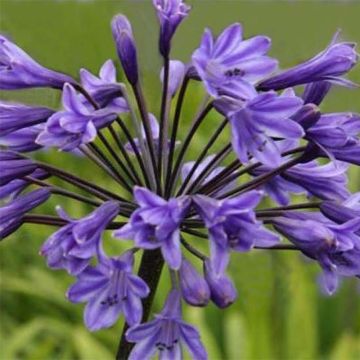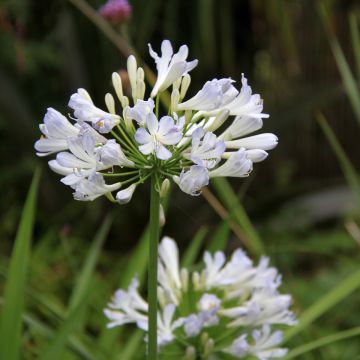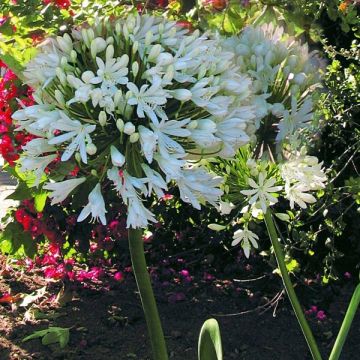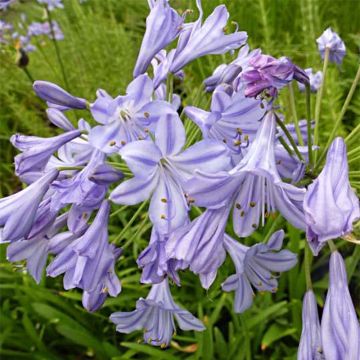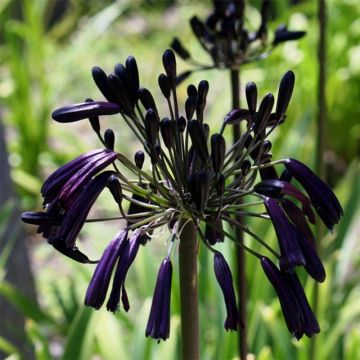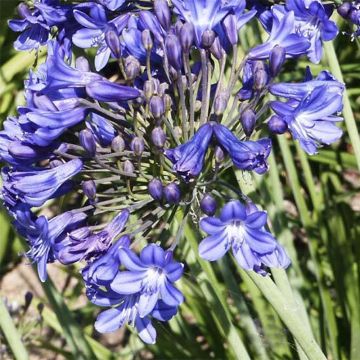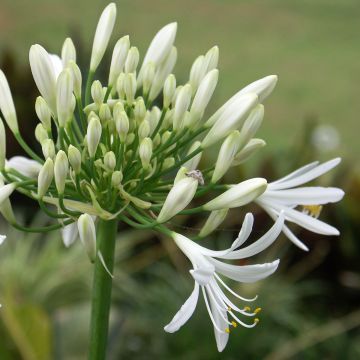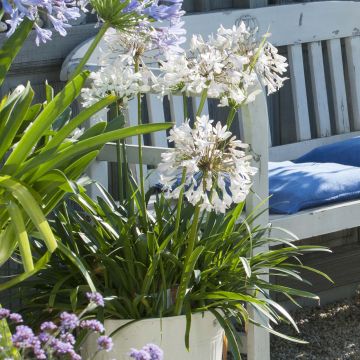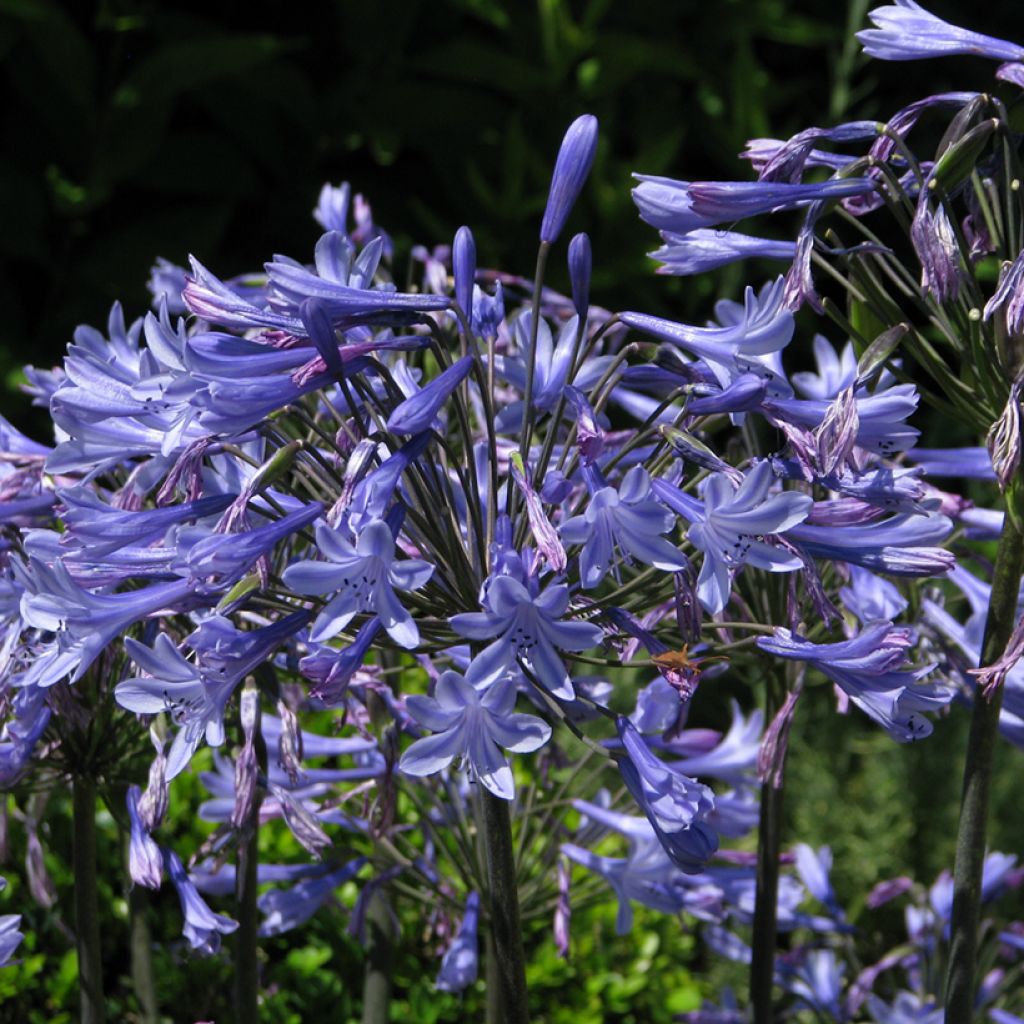

Agapanthus Blue Umbrella seeds - African lily
Agapanthus Blue Umbrella seeds - African lily
Agapanthus umbellatus Blue Umbrella
African Lily, Lily of the Nile
This item cannot be shipped to the selected country
Delivery charge from €5.90
More information
Schedule delivery date,
and select date in basket
This plant carries a 6 months recovery warranty
More information
We guarantee the quality of our plants for a full growing cycle, and will replace at our expense any plant that fails to recover under normal climatic and planting conditions.
From €5.90 for pickup delivery and €6.90 for home delivery
Express home delivery from €8.90.
Does this plant fit my garden?
Set up your Plantfit profile →
Description
Agapanthus umbellatus 'Blue Umbrella' is a spectacular perennial appreciated for its large umbels of deep blue flowers. Interesting for adding a touch of elegance and colour to the garden, it can be used in large borders, flower beds, or in large pots. Its evergreen foliage, combined with its magnificent summer flowering, makes it a plant of choice for creating a focal point.
This variety of Agapanthus 'Blue Umbrella' belongs to the Amaryllidaceae family. Agapanthus umbellatus (africanus) is a botanical species native to South Africa, where it grows in sunny meadows on well-drained soils. 'Blue Umbrella' forms dense clumps of long, ribbon-like, arching leaves, about 2 to 3 cm wide, dark green, which persist through winter in mild climates. Its flowers, grouped in large spherical umbels, 20 to 25 cm in diameter, appear at the top of rigid stems that can reach 1 to 1.5 m in height. Each umbel can contain up to 20 to 30 tubular flowers, of an intense blue, measuring about 5 cm long. Flowering occurs from July to September, depending on the climate. 'Blue Umbrella' is a relatively slow-growing plant, taking a few years to reach its mature size. But once established, it offers increasingly prolific flowering year after year.
Agapanthus 'Blue Umbrella' structures flower beds or borders, adding a pleasant exotic touch. It pairs beautifully with plants like Miscanthus, Echinaceas for a colour contrast, or even Gauras. In pots, it can be combined with dwarf Agapanthuses like 'Ever Sapphire' or white varieties like 'Albus', for a winning blue-white duo. For a mix of textures and heights, it can also be accompanied by verbena bonariensis or Kniphofia 'Royal Standard'.
Report an error about the product description
Flowering
Foliage
Plant habit
Botanical data
Agapanthus
umbellatus
Blue Umbrella
Amaryllidaceae
African Lily, Lily of the Nile
Agapanthus africanus Blue Umbrella
South Africa
Other Agapanthus - Lily of the Nile
Planting and care
The seeds of Agapanthus 'Blue Umbrella' should be sown between February and April for successful germination. Start by filling a seed tray or small pots with a fine, well-draining compost. Sow the seeds on the surface, then lightly cover them with a thin layer of compost or vermiculite, around 2 to 3 mm. Water gently to moisten the substrate without saturating it. Place the tray in a bright location, at a temperature of 15 to 20°C, while keeping the substrate slightly moist. Germination can take 3 to 8 weeks, depending on the growing conditions. Once the seedlings are sturdy enough, transplant them into individual pots and gradually acclimatise them outdoors before planting them in the ground after the last frost.
Cultivation:
Agapanthus 'Blue Umbrella' prefers a sunny exposure, although it can tolerate some partial shade. It thrives in well-draining soil, whether sandy, loamy, or clay, with a neutral to slightly acidic or alkaline pH. Ensure the soil does not become waterlogged, as excess moisture can lead to root rot. This plant is drought-resistant once established but will benefit from regular watering during dry periods, especially in summer.
In cold climates, it is a good idea to grow Agapanthus in a pot so it can be brought indoors in winter, as it cannot withstand temperatures below -5°C. In milder regions, it can remain in the ground year-round, but a protective mulch is advisable to protect the roots during winter. After flowering, remove faded flower stems to promote a new bloom the following year. Divide clumps every three to four years to maintain abundant flowering and prevent root overcrowding.
Sowing period
Intended location
This item has not been reviewed yet - be the first to leave a review about it.
Haven't found what you were looking for?
Hardiness is the lowest winter temperature a plant can endure without suffering serious damage or even dying. However, hardiness is affected by location (a sheltered area, such as a patio), protection (winter cover) and soil type (hardiness is improved by well-drained soil).

Photo Sharing Terms & Conditions
In order to encourage gardeners to interact and share their experiences, Promesse de fleurs offers various media enabling content to be uploaded onto its Site - in particular via the ‘Photo sharing’ module.
The User agrees to refrain from:
- Posting any content that is illegal, prejudicial, insulting, racist, inciteful to hatred, revisionist, contrary to public decency, that infringes on privacy or on the privacy rights of third parties, in particular the publicity rights of persons and goods, intellectual property rights, or the right to privacy.
- Submitting content on behalf of a third party;
- Impersonate the identity of a third party and/or publish any personal information about a third party;
In general, the User undertakes to refrain from any unethical behaviour.
All Content (in particular text, comments, files, images, photos, videos, creative works, etc.), which may be subject to property or intellectual property rights, image or other private rights, shall remain the property of the User, subject to the limited rights granted by the terms of the licence granted by Promesse de fleurs as stated below. Users are at liberty to publish or not to publish such Content on the Site, notably via the ‘Photo Sharing’ facility, and accept that this Content shall be made public and freely accessible, notably on the Internet.
Users further acknowledge, undertake to have ,and guarantee that they hold all necessary rights and permissions to publish such material on the Site, in particular with regard to the legislation in force pertaining to any privacy, property, intellectual property, image, or contractual rights, or rights of any other nature. By publishing such Content on the Site, Users acknowledge accepting full liability as publishers of the Content within the meaning of the law, and grant Promesse de fleurs, free of charge, an inclusive, worldwide licence for the said Content for the entire duration of its publication, including all reproduction, representation, up/downloading, displaying, performing, transmission, and storage rights.
Users also grant permission for their name to be linked to the Content and accept that this link may not always be made available.
By engaging in posting material, Users consent to their Content becoming automatically accessible on the Internet, in particular on other sites and/or blogs and/or web pages of the Promesse de fleurs site, including in particular social pages and the Promesse de fleurs catalogue.
Users may secure the removal of entrusted content free of charge by issuing a simple request via our contact form.
The flowering period indicated on our website applies to countries and regions located in USDA zone 8 (France, the United Kingdom, Ireland, the Netherlands, etc.)
It will vary according to where you live:
- In zones 9 to 10 (Italy, Spain, Greece, etc.), flowering will occur about 2 to 4 weeks earlier.
- In zones 6 to 7 (Germany, Poland, Slovenia, and lower mountainous regions), flowering will be delayed by 2 to 3 weeks.
- In zone 5 (Central Europe, Scandinavia), blooming will be delayed by 3 to 5 weeks.
In temperate climates, pruning of spring-flowering shrubs (forsythia, spireas, etc.) should be done just after flowering.
Pruning of summer-flowering shrubs (Indian Lilac, Perovskia, etc.) can be done in winter or spring.
In cold regions as well as with frost-sensitive plants, avoid pruning too early when severe frosts may still occur.
The planting period indicated on our website applies to countries and regions located in USDA zone 8 (France, United Kingdom, Ireland, Netherlands).
It will vary according to where you live:
- In Mediterranean zones (Marseille, Madrid, Milan, etc.), autumn and winter are the best planting periods.
- In continental zones (Strasbourg, Munich, Vienna, etc.), delay planting by 2 to 3 weeks in spring and bring it forward by 2 to 4 weeks in autumn.
- In mountainous regions (the Alps, Pyrenees, Carpathians, etc.), it is best to plant in late spring (May-June) or late summer (August-September).
The harvesting period indicated on our website applies to countries and regions in USDA zone 8 (France, England, Ireland, the Netherlands).
In colder areas (Scandinavia, Poland, Austria...) fruit and vegetable harvests are likely to be delayed by 3-4 weeks.
In warmer areas (Italy, Spain, Greece, etc.), harvesting will probably take place earlier, depending on weather conditions.
The sowing periods indicated on our website apply to countries and regions within USDA Zone 8 (France, UK, Ireland, Netherlands).
In colder areas (Scandinavia, Poland, Austria...), delay any outdoor sowing by 3-4 weeks, or sow under glass.
In warmer climes (Italy, Spain, Greece, etc.), bring outdoor sowing forward by a few weeks.

































